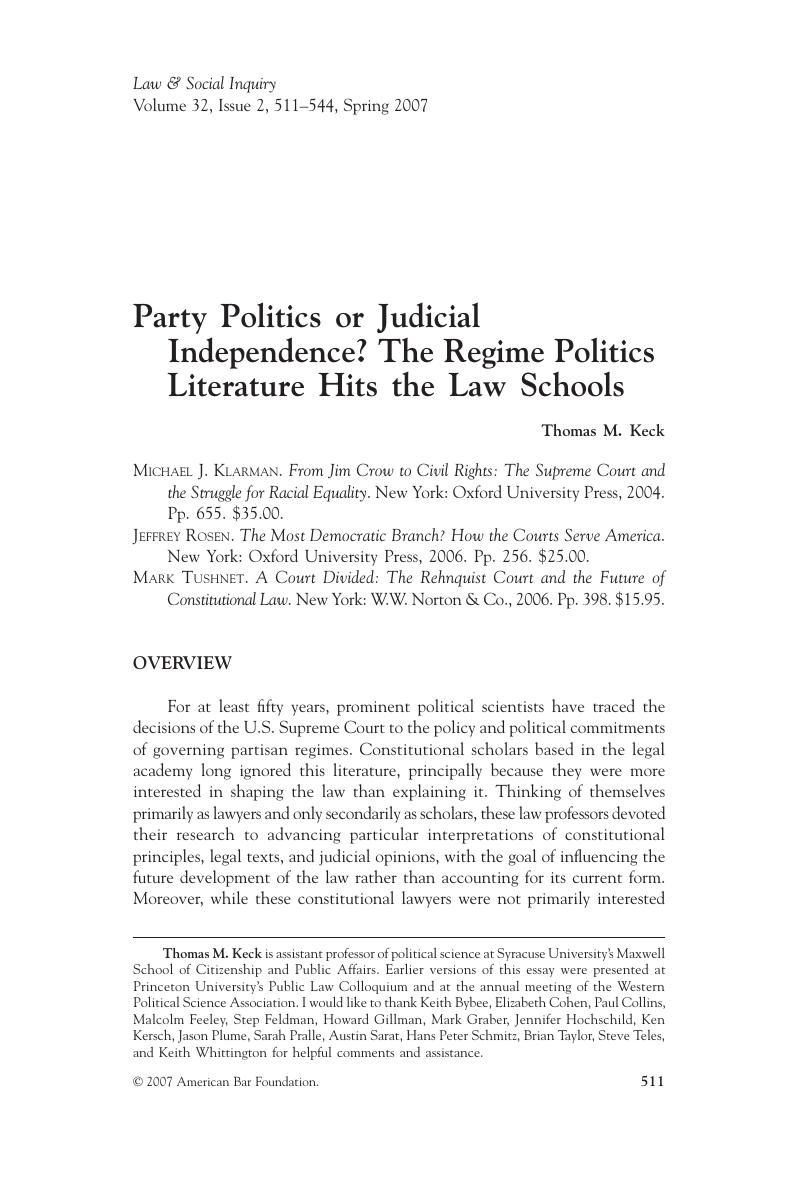Crossref Citations
This article has been cited by the following publications. This list is generated based on data provided by Crossref.
Burke, Thomas F.
2008.
Special Issue Constitutional Politics in a Conservative Era.
Vol. 44,
Issue. ,
p.
107.
Burbank, Stephen B.
2009.
On the Study of Judicial Behaviors: Of Law, Politics, Science and Humility.
SSRN Electronic Journal,
Narasimhan, Angela G.
2010.
Special Issue Interdisciplinary Legal Studies: The Next Generation.
p.
123.
Thomas, George
2011.
What Is Political Development? A Constitutional Perspective.
The Review of Politics,
Vol. 73,
Issue. 2,
p.
275.
Bybee, Keith J.
2012.
Paying Attention to What Judges Say: New Directions in the Study of Judicial Decision Making.
Annual Review of Law and Social Science,
Vol. 8,
Issue. 1,
p.
69.
Hall, Matthew E. K.
and
Black, Ryan C.
2013.
Keeping the Outliers in Line? Judicial Review of State Laws by the U.S. Supreme Court.
Social Science Quarterly,
Vol. 94,
Issue. 2,
p.
395.
Graber, Mark A.
2013.
Consequential Courts.
p.
363.
Sterett, Susan M.
2015.
Special Issue Cassandra’s Curse: The Law and Foreseeable Future Disasters.
Vol. 68,
Issue. ,
p.
95.
Hall, Matthew E. K.
and
Ura, Joseph Daniel
2015.
Judicial Majoritarianism.
The Journal of Politics,
Vol. 77,
Issue. 3,
p.
818.
Bridge, Dave
2015.
The Supreme Court, Factions, and the Counter-Majoritarian Difficulty.
Polity,
Vol. 47,
Issue. 4,
p.
420.
Hall, Matthew E.K.
2016.
Judicial Review as a Limit on Government Domination: Reframing, Resolving, and Replacing the (Counter)Majoritarian Difficulty.
Perspectives on Politics,
Vol. 14,
Issue. 2,
p.
391.
Keck, Thomas M.
and
McMahon, Kevin J.
2016.
Studies in Law, Politics, and Society.
Vol. 70,
Issue. ,
p.
33.
Kastellec, Jonathan P.
2016.
Empirically Evaluating the Countermajoritarian Difficulty.
Journal of Law and Courts,
Vol. 4,
Issue. 1,
p.
1.
Keck, Thomas M.
2017.
Medium- and Large-N Qualitative Methods in Constitutional Law.
SSRN Electronic Journal,
2018.
Almost Citizens.
p.
160.
2018.
Almost Citizens.
p.
162.
Macfarlane, Emmett
2018.
“You Can't Always Get What You Want”: Regime Politics, the Supreme Court of Canada, and the Harper Government.
Canadian Journal of Political Science,
Vol. 51,
Issue. 1,
p.
1.
Cash, Jordan T.
and
Bridge, Dave
2018.
Donald Trump and Institutional Change Strategies.
Laws,
Vol. 7,
Issue. 3,
p.
27.
Conway, Nicholas D.
Jordan, Soren
and
Ura, Joseph Daniel
2018.
Courts and Issue Attention in Canada.
Social Science Quarterly,
Vol. 99,
Issue. 4,
p.
1324.
Rogers, James R.
and
Ura, Joseph Daniel
2020.
A majoritarian basis for judicial countermajoritarianism.
Journal of Theoretical Politics,
Vol. 32,
Issue. 3,
p.
435.



